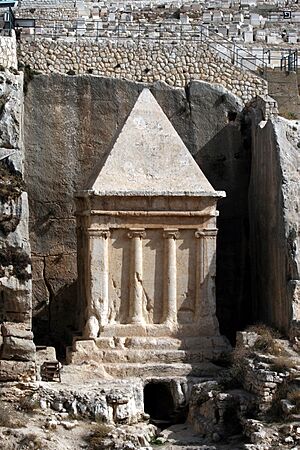Tomb of Zechariah (Ben Jehoiada) facts for kids
The Tomb of Zechariah is a famous ancient monument located in the Mount of Olives Jewish Cemetery in Jerusalem. It's not actually a tomb where someone is buried, but rather a solid stone monument carved right out of the rock! It's believed to be a memorial for a person named Zechariah, possibly Zechariah Ben Jehoiada, a priest mentioned in the Bible.
Contents
What is the Tomb of Zechariah?
This unique structure is a single, solid piece of rock that has been carved into the shape of a monument. It stands out because it's not a building you can go inside. Instead, it's a giant, decorative stone marker.
How Old is This Monument?
Experts believe the Tomb of Zechariah was carved around the 1st century BCE (Before Common Era). This means it's over 2,000 years old! It was created during a time when many impressive rock-cut tombs and monuments were built in the area.
Who Was Zechariah?
The monument is named after Zechariah, but it's not certain which Zechariah it refers to. One popular idea is that it honors Zechariah Ben Jehoiada, a priest from the Old Testament. He was known for speaking out against the king and was sadly killed in the courtyard of the Temple.
Where Can You Find It?
The Tomb of Zechariah is located in the Kidron Valley, which is a valley just east of the Old City of Jerusalem. This valley is famous for its many ancient burial sites and monuments. The tomb is part of a group of impressive rock-cut structures, including the Tomb of Absalom and the Tomb of Bene Hezir.
Why is it Important?
The Tomb of Zechariah is important for several reasons:
- Ancient Art: It shows amazing ancient carving skills. The monument has a pyramid-shaped roof and columns, which are typical of ancient Greek and Roman styles.
- Historical Mystery: It helps us learn about the history of Jerusalem and the people who lived there thousands of years ago, even if we don't know all the details.
- Religious Significance: For many people, especially those of Jewish faith, the Mount of Olives and its monuments hold deep religious meaning.


